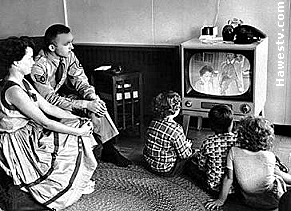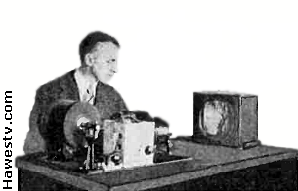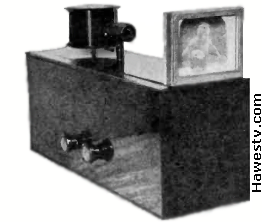| • NOTICE. For more information on a topic, you may click the related footnote number. (Example: [3.]) |
The Lost Creations of Leslie Gould
Hemispherical Television
|
|
Early Television Transmissions. Long before commercial television stations came on the air, Gould demonstrated his “Hemispherical Television System.” As Bridgeport Post photographer Al Mathewson recalled, this system transmitted over a one-mile path. The television picture had only 7,200 pixels, and must have looked coarse. (If the picture were square, each frame would have consisted of only 96 lines.) [1.] Gould showed off this groundbreaking system in 1938. [2.] |
|
|
|
Forgotten Gould Patents
Gould harnessed his dreams, with gears, motors, and vacuum tubes. A Google search for Gould's patents finds seven (including three in television). [3.] Here are details about a few of Gould's contributions to commerce and industry...
2D Television Projectors
Two types. In the July, 1930 Radio-Craft, Cockaday discussed two projectors that Gould designed, patents 2,086,382 and 2,176,856. [4.] We'll call projector 2,086,382 “Type 1.” [5.] Projector 2,176,856 will be “Type 2.” [6.] Both projectors used Heising modulation to excite the neon tubes. [7.], [8.], [9.] Gould's projectors must have inspired the development of his intriguing 3D television system.
|
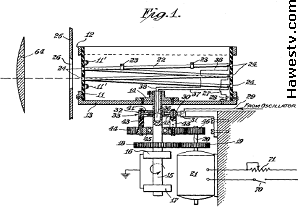
Fig. D. Drum drawing from Gould's 1932 projector patent 2,176,856. Drum rotates horizontally, like drum in Fig. C. [14.] |
A Type-1 projector scanned vertically, by means of a drum that rotated on a horizontal axis. (See Fig. B.) Every few degrees around a Type-1 drum were cylindrical, neon column tubes. These tubes looked like illuminated pencils. These were not typical, plate-kino tubes that most television sets of the time used. The Gould tubes put out red or “green” (likely cyan) light. A slotted disc before the drum provided the horizontal (frame) scanning. [15.], [16.] A Type-2 projector scanned horizontally. Its scanning drum rotated on a vertical axis. (See Fig. D.) Attached to the inside of the drum was a helical neon column tube. A spiral of holes in the drum allowed the viewer to see the tube. The holes scanned across the frame. At any instant, only one hole was visible. There were two turns in the neon tube. At the top of the hole spiral, the viewer would see pixels from the top turn. The scan progressed to the bottom turn of the tube. Then a commutator switched off the top turn. The switch also connected the bottom turn. The bottom turn seamlessly illuminated the rest of the screen. [17.], [18.] Some advantages of Gould's projectors... [19.], [20.]
|
Gould's FM Phonograph Pickup
Improved tonearm. In 1941, Gould patented an improvement to the standard phonograph of the time (probably 78 rpm). Gould's tonearm (phono pickup) included a one-tube FM modulator. The phono deck with this modulator could play through a radio. The radio would eliminate the need for separate amplifiers and speakers. [21.]

Gould's phono deck with a built-in FM modulator, plays through a radio. Highlights: 12—RF shield; 19-22—Transducer; 23—Stylus; 25—Moving coil; 26—RF coil; 27—Triode tube; 33—Tuning cap. Patent also includes schematic. [22.]
AM or FM. The patent mentions that the modulator would also work with an AM radio. The AM radio would tune the FM signal from the phonograph using slope detection. That is, tuning to one side of the carrier. As you can see from the patent drawing, the tonearm is large enough to include a vacuum tube. (See “27” on the drawing). In fact, the entire, electron-coupled RF oscillator is inside the tonearm. The cartridge is a moving-coil type. Movement of stylus 23 deflects coil 26, altering the carrier frequency. The resting carrier frequency is adjustable at capacitor 32. [23.]
Gould's Consulting Business
|
Vituoso. Leslie A. Gould would have been an asset to any innovative R&D or manufacturing company. His virtuosity as an electrical and mechanical engineer ran second to none. His talent and knowledge as a researcher, analyst, and machinist further enhanced his value. |
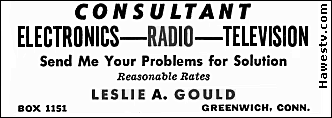
Gould's 1948 classified ad for his services (Popular Mechanics) [24.] |
Groundbreaking. That Gould became a consulting design engineer isn't surprising. To the right is an advertisement for his services that appeared in a 1948 issue of Popular Mechanics. Years after his groundbreaking 3D television, Gould remained an unconventional thinker who brought daydreams to life.
Gould at PomonaAfter his Bridgeport, Connecticut days, Gould moved to Pomona, California. There, he spent the last nine years of his life. Meanwhile, he continued to experiment in a small lab. [25.] Gould reached the age of 83 before he died on September 23, 1974. [26.], [27.] Right: Gould, in later years. [28.] |
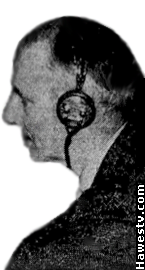
|
Spectrac: Color Shows on Black & White TVs
Color TV! When it arrived, it was expensive. Out of reach for the average family. Besides, not many shows were in color. Eventually though, most shows did switch to color. Yet a color TV still cost too much. Then along came the $100 Spectrac kit: Color for the black-and-white TV we already owned. Here's the story...
SPECTRAC
Footnotes
1. Robert L. Sawyer, “Leslie A. Gould, 88, dies; Area Engineer, TV Pioneer,” Bridgeport Sunday Post, October 20, 1974, 21. •Re: Gould demonstrates what he calls his “Hemispherical Television System.” Transmission of 7,200-pixel images over one-mile span.
2. N.A., “20 Years Ago In the Post (From Our Files, May 27, 1938),” Bridgeport Post, Tuesday, May 27, 1958, 26. •Re: Leslie A. Gould made first demonstration of television in Bridgeport, using transmitter & receivers he invented. Event took place in 1938 at Loew Poli Theater lobby. Article claims that Gould engineered method of broadcasting of motion pictures over TV.
3. Patents.google.com. https://patents.google.com/?inventor=leslie+a.+gould&oq=leslie+a.+gould (access on December 12,2021). •Re: Google Patents site. The link is the result of a search on “Leslie A. Gould.” The author discovered seven patents, of which three were for television devices.
4. Laurence M. Cockaday, “The Latest Developments in Television Methods,” Radio Craft, July, 1930, 24. •Re: Gould 2D projector patents, Type 1 (U.S. patent 2,086,382) & Type 2 (U.S. patent 2,176,856). Article includes drawings, photos, & device descriptions.
5.
Leslie A. Gould, Television Receiving Apparatus [Projector patent, Type 1]
U.S. Patent 2,086,382 filed October 29, 1931, and issued July 6, 1937. Assignee: Radio Inventions,
Inc.
https://patents.google.com/patent/US2086382A/en?oq=U.S.+patent+2%2c086%2c382
•Re: Gould's 2D, large-screen color television projector & direct-view monitor:
“Type 1” refers to Gould's 1931 patent on television with gas column tubes
& enlarged screen. (As vs. flat-plate neon tubes, typical in art of 1928 through 1934).
Type-1 monitors provide projected or direct-view pictures.
6.
Leslie A. Gould, Television Apparatus and Method [Projector patent, Type 2], U.S.
Patent 2,176,856 filed January 23, 1932, and issued October 17, 1939. Assignee: Radio Inventions,
Inc.
https://patents.google.com/patent/US2176856A/en?oq=U.S.+patent+2%2c176%2c856
•Re: Gould's 2D, large-screen monochrome television projector & direct-view monitor:
“Type 2” refers to Gould's 1932 patent on monitor with drum that rotates
horizontally, not vertically, as in Type-1 models. Type-2 sets used helical neon tube. This
tube was gas-column type, not the flat-plate type that was common in 1930s mechanical
television.
7. Cockaday, “The Latest Developments in Television Methods,” 23 & 24. •Re: Gould excites his neon glow tubes with Heising modulator.
8.
Gould, Television Receiving Apparatus [Projector patent, Type 1], 3,
Column 2.
https://patents.google.com/patent/US2086382A/en?oq=U.S.+patent+2%2c086%2c382
•Re: Gould's use of Heising modulator to excite neon tube in Type-1 (color)
monitor. This is monitor with vertical scanning drum.
9.
Gould, Television Apparatus and Method [Projector patent, Type 2].
https://patents.google.com/patent/US2176856A/en?oq=U.S.+patent+2%2c176%2c856
•Re: Gould's use of Heising modulator to excite neon tube in Type-2 (monochrome)
monitor. This is monitor with horizontal scanning drum.
10. Cockaday, “The Latest Developments in Television Methods,” 24. •Re: (Graphic.) Gould portrait with his mechanical television projector, Type 1. Photo shows vertical scanning drum (on horizontal axis), indicating U.S. patent 2,086,382 (Type 1). For clarity, author Hawes retouched & vignetted portrait. Article includes further drawings, photos, & description of device. Scanning drum in projector uses red & “green” gas-column neon tubes.
11. N.A., “Television in Three Dimensions,” Modern Mechanics and Inventions, February, 1931, 67. •Re: (Graphic.) Vignetted photo of Gould, sitting with his desktop television projector, Type 1. (Same shot as in Radio-Craft, only with retouching by the magazine.) Rest of article is about Gould's 3D system.
12. Cockaday, “The Latest Developments in Television Methods,” 24. •Re: (Graphic.) Gould's desktop television projector, U.S. patent 2,086,382. Drum on horizontal axis that scans picture frame vertically, with neon tubes of alternating colors. (Colors: Red & “green.” Green may be imprecise term for “cyan.”) This monitor could have reproduced color or black-and-white pictures. Gould achieved horizontal scanning with slotted disc. (For clarity, author Hawes minimally retouched diagram.)
13. Ibid. •Re: (Graphic.) Photo of Gould's desktop television projector, Type 2, in cabinet. (Drum on vertical axis scans frame horizontally.) This is the monochrome monitor. For clarity, author Hawes retouched & vignetted photo.
14.
Gould, Television Apparatus and Method [Projector patent, Type 2].
https://patents.google.com/patent/US2176856A/en?oq=U.S.+patent+2%2c176%2c856
•Re: (Graphic.) Patent drawing (Figure 1) from Gould's 2D, monochrome television
projector (“Type 2”). Shows drum that rotates horizontally.
15.
Gould, Television Receiving Apparatus [Projector patent, Type 1].
https://patents.google.com/patent/US2086382A/en?oq=U.S.+patent+2%2c086%2c382
•Re: Discussion of patent for Gould's 2D, large-screen color television projector &
direct-view monitor.
16. Cockaday, “The Latest Developments in Television Methods,” 24. •Re: Description of Gould Type-1 projector (the two-color projector). Article includes graphics. Projector uses vertical scanning drum with built-in red & “green” neon gas-column tubes.
17.
Gould, Television Apparatus and Method [Projector patent, Type 2],
1, Column 2.
https://patents.google.com/patent/US2176856A/en?oq=U.S.+patent+2%2c176%2c856
•Re: U.S. patent 2,176,856 for Gould Type-2 projector (the monochrome projector).
Projector uses horizontal scanning drum with built-in helical, neon gas-column tube.
18. Cockaday, “The Latest Developments in Television Methods,” 24. •Re: Description of Gould Type-2 projector (the monochrome projector). Article includes graphics. Projector uses horizontal scanning drum with built-in helical, neon gas-column tube.
19.
Gould, Television Receiving Apparatus [Projector patent, Type 1], 1.
https://patents.google.com/patent/US2086382A/en?oq=U.S.+patent+2%2c086%2c382
•Re: U.S. Patent 2,086,382 for Gould Type-1 projector (the color projector).
Vertical scanning with drum incorporating several straight tubes in two colors. For
projected or direct-view pictures.
20.
Gould, Television Apparatus and Method [Projector patent, Type 2],
1.
https://patents.google.com/patent/US2176856A/en?oq=U.S.+patent+2%2c176%2c856
•Re: U.S. Patent 2,176,856 for Gould Type-2 projector (the monochrome projector).
Horizontal scanning with drum and helical tube. For projected or direct-view pictures.
21.
Leslie A. Gould, Frequency-Modulation Phonograph Pickup System [Phono patent],
U.S. Patent 2,441,354 filed January 17, 1941, and issued May 11, 1948, Fig. 1. Assignee: Maguire
Industries, Inc.
https://patents.google.com/patent/US2441354A/en?oq=U.S.+patent+2%2c441%2c354
•Re: FM phono patent, entire. Brief document convers electromechanical device that
replaces normal tonearm & plays through radio: FM in preferred embodiment, but also AM.
(RF modulator.) No phono preamp, power amp, or speakers are necessary.
22.
Ibid. [Phono patent], Fig. 1.
https://patents.google.com/patent/US2441354A/en?oq=U.S.+patent+2%2c441%2c354
•Re: (Graphic) FM phono patent, showing tonearm (pickup arm) at Figure 1.
Tonearm includes FM modulator tube in electron-coupled oscillator circuit.
23. Ibid. [Phono patent]. •Re: Gould FM tonearm (pickup) device. With Gould's tonearm, phonograph plays through FM (or AM) radio through RF modulator. Entire RF modulator is inside tonearm (pickup).
24. Leslie A. Gould, “Consultant: Electronics—Radio—Television,” (Classified advertisement) Popular Mechanics, April, 1948, 72. •Re: (Graphic) Gould's ad for his services as consulting engineer.
25. Sawyer, “Leslie A. Gould, 88, dies; Area Engineer, TV Pioneer,” 21. •Re: Gould spent last 9 years of his life in Pomona, California.
26. Ibid. •Re: According to the Post, Gould was 88 when he died on September 23, 1974. (Death age is likely incorrect.) Note 29, below, gives both birth & death dates.
27.
Find a Grave, “Memorial page for Leslie A. Gould (February 18, 1891 to
September 19, 1974).”
https://www.findagrave.com/memorial/134543656/leslie-a-gould (Access on
December 18, 2021). •Re: Gives birth & death dates for Leslie A. Gould.
According to this page, Gould was 83, not 88, when he died.
28. Sawyer, “Leslie A. Gould, 88, dies.” •Re: (Graphic.) Gould in later years: Portrait from Bridgeport Post obituary (1974). (For clarity, author Hawes extensively retouched & portrait.)
Go to Page: 1 2 3 4 5 6 7 8 9 Next
GOULD 3D TELEVISION
GOULD 3D: COULD IT WORK?
GOULD 3D: FORMULAS
GET A WHEEL
Page Directory
On this page...The Lost Creations of Leslie Gould Hemispherical Television Forgotten_Gould_Patents 2D Television Projector Gould's FM Phonograph Pickup Gould's Consulting Business Gould at Pomona Spectrac: Color Shows on Black & White TVs Footnotes
On related pages...
What is Two-Color TV? Col-R-Tel vs. Spectrac Two-Color TV History TV System Flicker Comparison TV System Flicker Comparison 2.5-Color TV Gould Television: 3D from the Great Depression Gould 3D: Could it Work? Gould 3D: Camera & Monitor Formulas Spectrac: Color for a Monochrome World
